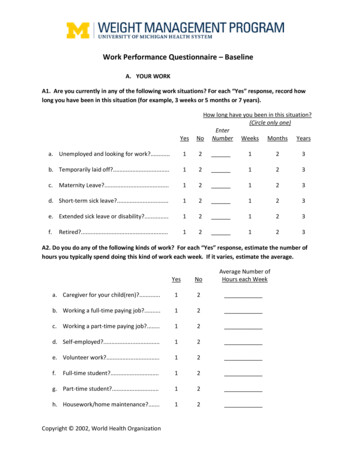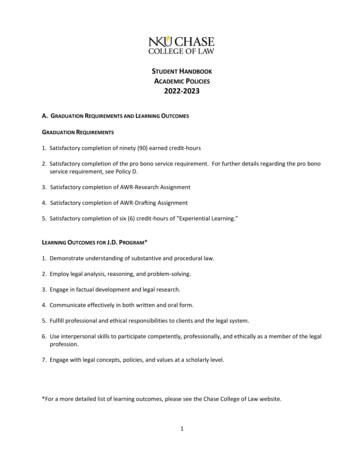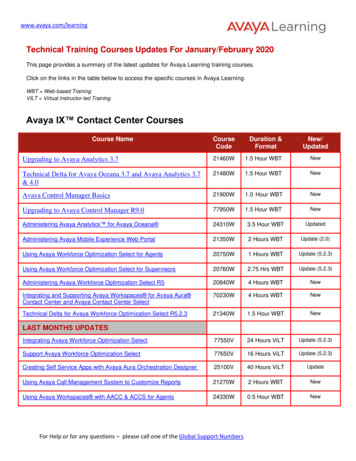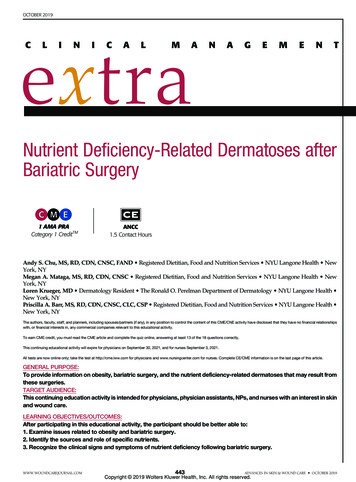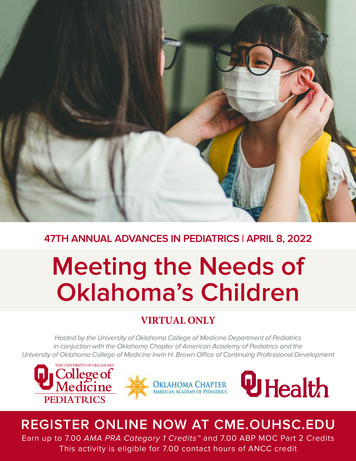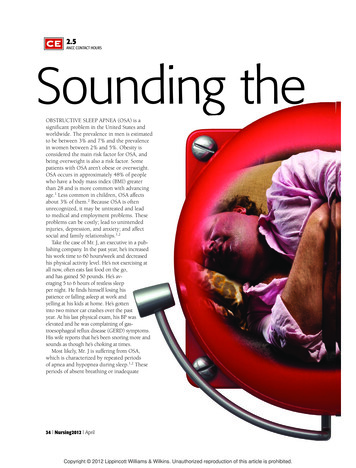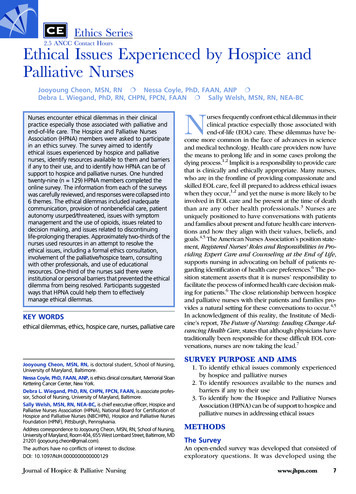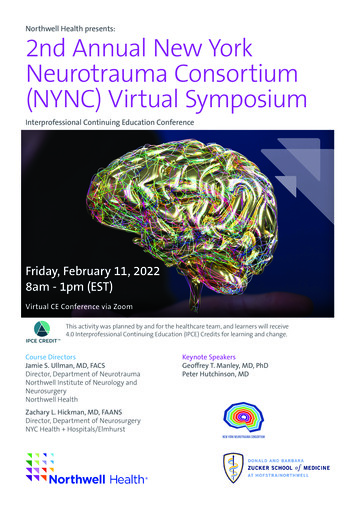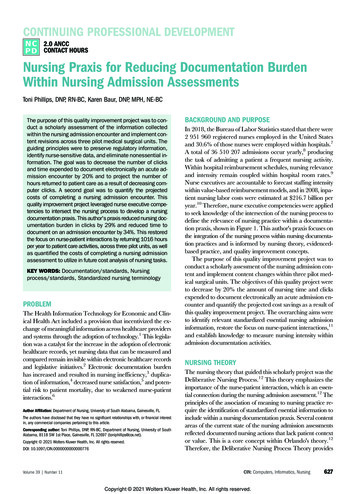
Transcription
CONTINUING PROFESSIONAL DEVELOPMENT2.0 ANCCCONTACT HOURSNursing Praxis for Reducing Documentation BurdenWithin Nursing Admission AssessmentsToni Phillips, DNP, RN-BC, Karen Baur, DNP, MPH, NE-BCThe purpose of this quality improvement project was to conduct a scholarly assessment of the information collectedwithin the nursing admission encounter and implement content revisions across three pilot medical surgical units. Theguiding principles were to preserve regulatory information,identify nurse-sensitive data, and eliminate nonessential information. The goal was to decrease the number of clicksand time expended to document electronically an acute admission encounter by 20% and to project the number ofhours returned to patient care as a result of decreasing computer clicks. A second goal was to quantify the projectedcosts of completing a nursing admission encounter. Thisquality improvement project leveraged nurse executive competencies to intersect the nursing process to develop a nursingdocumentation praxis. This author's praxis reduced nursing documentation burden in clicks by 29% and reduced time todocument on an admission encounter by 34%. This restoredthe focus on nurse-patient interactions by returning 1016 hoursper year to patient care activities, across three pilot units, as wellas quantified the costs of completing a nursing admissionassessment to utilize in future cost analysis of nursing tasks.KEY WORDS: Documentation/standards, Nursingprocess/standards, Standardized nursing terminologyPROBLEMThe Health Information Technology for Economic and Clinical Health Act included a provision that incentivized the exchange of meaningful information across healthcare providersand systems through the adoption of technology.1 This legislation was a catalyst for the increase in the adoption of electronichealthcare records, yet nursing data that can be measured andcompared remain invisible within electronic healthcare recordsand legislative initiatives.2 Electronic documentation burdenhas increased and resulted in nursing inefficiency,3 duplication of information,4 decreased nurse satisfaction,5 and potential risk to patient mortality, due to weakened nurse-patientinteractions.6Author Affiliation: Department of Nursing, University of South Alabama, Gainesville, FL.The authors have disclosed that they have no significant relationships with, or financial interestin, any commercial companies pertaining to this article.Corresponding author: Toni Phillips, DNP, RN-BC, Department of Nursing, University of SouthAlabama, 8118 SW 1st Place, Gainesville, FL 32697 (toniphillips@cox.net).Copyright 2021 Wolters Kluwer Health, Inc. All rights reserved.DOI: 10.1097/CIN.0000000000000776Volume 39 Number 11BACKGROUND AND PURPOSEIn 2018, the Bureau of Labor Statistics stated that there were2 951 960 registered nurses employed in the United Statesand 30.6% of those nurses were employed within hospitals.7A total of 36 510 207 admissions occur yearly,8 producingthe task of admitting a patient a frequent nursing activity.Within hospital reimbursement schedules, nursing relevanceand intensity remain coupled within hospital room rates.9Nurse executives are accountable to forecast staffing intensitywithin value-based reimbursement models, and in 2008, inpatient nursing labor costs were estimated at 216.7 billion peryear.10 Therefore, nurse executive competencies were appliedto seek knowledge of the intersection of the nursing process todefine the relevance of nursing practice within a documentation praxis, shown in Figure 1. This author's praxis focuses onthe integration of the nursing process within nursing documentation practices and is informed by nursing theory, evidencedbased practice, and quality improvement concepts.The purpose of this quality improvement project was toconduct a scholarly assessment of the nursing admission content and implement content changes within three pilot medical surgical units. The objectives of this quality project wereto decrease by 20% the amount of nursing time and clicksexpended to document electronically an acute admission encounter and quantify the projected cost savings as a result ofthis quality improvement project. The overarching aims wereto identify relevant standardized essential nursing admissioninformation, restore the focus on nurse-patient interactions,11and establish knowledge to measure nursing intensity withinadmission documentation activities.NURSING THEORYThe nursing theory that guided this scholarly project was theDeliberative Nursing Process.12 This theory emphasizes theimportance of the nurse-patient interaction, which is an essential connection during the nursing admission assessment.12 Theprinciples of the association of meaning to nursing practice require the identification of standardized essential information toinclude within a nursing documentation praxis. Several contentareas of the current state of the nursing admission assessmentsreflected documented nursing actions that lack patient contextor value. This is a core concept within Orlando's theory.12Therefore, the Deliberative Nursing Process Theory providesCIN: Computers, Informatics, NursingCopyright 2021 Wolters Kluwer Health, Inc. All rights reserved.627
CONTINUING PROFESSIONAL DEVELOPMENTFIGURE 1. Nursing praxis for evidence-based documentation.a framework for this project's integration of standardized essential patient information gathered from nursing assessments.The elimination of extraneous nursing documentation such asthe documentation in the electronic healthcare record of patient belongings fails to provide information that contributesto the care of the patient. As a result of this project, nursing documentation praxis was established to decrease nursing documentation burden and demonstrate evidence of interventionsthat return nursing time to nurse-patient interactions.13QUALITY IMPROVEMENT MODELThe quality improvement model chosen was Kurt Lewin'schange theory14 as the key concepts of unfreezing-changerefreezing was applicable to reviewing structure, process,and content within the current admission assessment as theytraverse the nursing process concepts within this documentation praxis. The principles leveraged to inform localdiscussions and decisions regarding admission content wereadopted from the work of the Transforming DocumentationWorkgroup15 and the American Nurses Association.16 Nursing admission content was reviewed by the facility expertpanel of nurses appointed by nursing leadership within theshared governance documentation committee and furtherinformed by national nursing modernization efforts duringthe unfreezing stage. These groups of nurses searched forevidenced-based knowledge on scales, tools, nursing terms,and observations to include or exclude within the nursingadmission assessment encounter revisions.In addition, regulatory, local, and national nursing policieswere reviewed to assess inclusion or exclusion of applicablecontent. The design of the electronic templates was reviewedto seek and implement functionality, which reduced redundancy in clicks, and identify nursing content as the source oftruth for information to decrease redundancy in duplicativedocumentation. The content within the admission assessment628was changed, and refreezing of nursing content occurred toleverage information to assess changes in content.Point-of-care training was conducted on all three shiftsprior to unfreezing the revised admission assessment. Onepilot unit at a time implemented the changes to support staffquestions during the implementation. Future scholarship willevolve around the repetition of this process to evolve new orabsent relevant standardized nursing content and to determineassociations between standardized nursing documentation, patient outcomes, and nursing intensity. The overarching qualityimprovement initiative is to return nurses' time to patient careand surveillance as opposed to time spent on irrelevant nursingdocumentation.LITERATURE REVIEWThe literature search reviewed 53 studies, of which 34 studies provided the foundational evidence to inform this praxisto reduce nursing documentation burden and measure thecosts of completing a nursing admission assessment. Of these34 studies, 20 were qualitative studies and 14 were quantitative studies. Qualitative studies summarized evidence thatsupports the integration of the nursing process within thedocumentation praxis and quantitative studies informedthe value of critical elements within nursing data to impactpatient outcomes and measure nursing intensity. Searchterms included praxis, nursing minimum data set, standardized patient care data, and electronic documentation burden.One level V systematic review17 quantified the evidenceon nursing documentation practices and provided documentation recommendations that promote standardization ofcontent and expression of nursing practice. In addition, asecond level V systematic review analyzed structured patientcare content as it impacts primary and secondary use of electronic documentation.18 The synthesis of this informationprovided project insight into the content review and changes,CIN: Computers, Informatics, NursingCopyright 2021 Wolters Kluwer Health, Inc. All rights reserved.November 2021
to identify essential nursing content as the source of truth forinformation such as with mental health or infectious diseasescreenings. The literature provided guidance and synthesisof knowledge as a result of the findings of repetitive themes,such as lack of standardization in nursing content,19 poor designs that lack integration into nursing workflows,20 and absence of the identification of nursing costs as a by-product ofnursing documentation.21 The examination of these common themes from the literature review informed the framework for the nursing documentation praxis, as well as theproject design and aims.PARTICIPANTS AND PROTECTION OF HUMANSUBJECTSProject participants were volunteers and the admissiondata collections were dependent upon when admissionsoccurred on the three pilot medical surgical units. Analysisof 3 months of admission data demonstrated that 80% ofadmissions occur between the hours of 12 noon and 8PM, which guided the collection of time measurementdata. Nurse participants included licensed registered nurseson the three pilot units; staff who floated to these units wereexcluded.Voluntary participation in the time studies was solicited tomeasure the amount of time to complete an admission assessment. The number of nurses who participated in thebaseline time studies consisted of 20 registered nurses, withthe average years in nursing consisting of 10 years. The number of nurses who participated in the postintervention admission assessment time studies was 18, with the average years innursing consisting of 9.4 years.The project was submitted to the University of Alabama'sInstitutional Review Board and was determined to be a systemchange, quality improvement project. University guidelinesand course objectives were adhered to within the project.In addition, review of the project prior to implementationwas conducted by the facilities scholarly review board anddetermined to be a quality improvement project. Finally, review and approval from local labor unions was receivedprior to project initiation as required by facility regulations.DATA COLLECTIONExamining the quality and quantity of information withinthe nursing electronic admission assessment, hours returnedto patient care as a result of the revised admission assessment,and projected costs to complete an admission assessment wasthe focus of the data collection for this project. The quality ofinformation was examined from the preintervention admission assessment as described in the quality improvementsection to determine content changes and identification ofterms and/or observations that would provide nursing valueto the care of patients.22 The quality of nursing admissionVolume 39 Number 11assessment content was further reviewed by facility sharedgovernance committees in comparison with evidenced-basedcontent decisions from national nursing modernization initiatives to inform assessment revisions. In addition, policy, regulatory elements, and operational metrics were reviewed toidentify key areas necessary for compliance. Interprofessionalconsulting was done to obtain advisement on content and usability from clinical informatics, health information management, hospitalists, quality safety and value, nurse educators,nurse managers, and nursing leadership. This collaborationresulted in a comprehensive analysis and identification ofelimination of content redundancy and provided opportunities to identify the source of truth for information. This permits the reuse of information across administrative processesor clinical documentation to eliminate redundant or nonessential documentation data elements.The quantity of data entry points was obtained throughmanual counting of the total number of possible data entrypoints within the preadmission and revised postassessmentdocumentation template. In addition, nursing quantity wasmeasured by a review of each content item to identifythe total number of possible mouse clicks depending upontemplate design.23 Total hours to complete mouse clickswas calculated pre and post admission assessment revisionbased on three mouse clicks24 and multiplied by the averagenumber of admission encounters, recognizing that wirelessaccess points, age of equipment, and bandwidth can impactfunctionality.The average number of admission encounters for 3months was used in the calculation of the projected hoursto complete an admission assessment. Time measurementto complete the admission assessment was captured throughdirect observation of 20 nurses from the start through completion of the admission assessment across the three pilotunits over a 2-month period.25 Computer connectivity andnurse interruptions were deducted from the overall time captured. The average admissions were multiplied by the average time to complete an admission assessment, and thisfigure was used to project the number of hours per year forregistered nurses to complete an admission assessment, asshown in Table 1. This analysis was done with the admissionassessments to use for comparative analysis with pre and postadmission assessment revisions as well as to assign costs to thenursing admission activity.Nursing cost projections for completing an admission assessment were determined by using several data points. Forecasted nursing costs were measured by obtaining baselinesalary data, absent of fringe benefits, to determine an average hourly salary rate for each pilot unit. The total amountof hours to complete an admission assessment each yearwas multiplied by the hourly rate. The projected yearly nursing costs associated with the activity of a nursing admissionCIN: Computers, Informatics, NursingCopyright 2021 Wolters Kluwer Health, Inc. All rights reserved.629
CONTINUING PROFESSIONAL DEVELOPMENTTable 1. Documentation Efficiency and Cost Analysis Pre and Post Admission Assessment RevisionsCost-Benefit Analysis: Nursing DocumentationGoal: Decrease electronic documentation burden by 20%, measured in clicks, RN hours, RN salaryGoal met—29% decrease in documentation burden measured by clicks, 35% decrease in time spent electronically documenting an admission assessmentTotal # of possible mouse clicksPilotunitsRN averagehourly rate123Totals 44.78 45.33 42.55 ventionclicks109410941094assessment were assigned using these data points, as shownin Table 1.FINDINGSAn average of 453 admissions occurred in 3 months withinthe three pilot medical surgical units. Preintervention admission assessment findings were analyzed and a total of1175 possible data elements and 1094 mouse clicks existedwithin the admission assessment. Preintervention, an average of 31.71 minutes was recorded to complete the currentadmission assessment. The postintervention revised admission assessment contained a total of 835 possible dataelements and 744 mouse clicks, which included core content related to regulatory, core assessment information andscreening tools such as alcohol, tobacco, and mental health.This resulted in a decrease of 340 possible data elements anda decrease of 350 clicks for a total of 29% decrease in electronic documentation burden and was supported in theliterature. In addition, an average of 20.30 minutes wasrecorded to complete the postintervention revised admission assessment. This resulted in a 35% decrease in timespent electronically documenting a nursing admission assessment encounter.The time to complete the preintervention admission assessment per year was 580 hours for pilot unit 1, 1215 hoursfor pilot unit 2, and 1065 hours for pilot unit 3. The totaltime to complete the preintervention admission assessmentwas 2860 hours per year across the three pilot units. Thetime to complete the postintervention revised admission assessment was 357 hours for pilot unit 1, 778 hours for pilotunit 2, and 709 hours for pilot unit 3 per year. The total timeto complete the postintervention revised admission assessment was 1844 hours per year across all three pilot units.This resulted in a total of 1016 hours that could be eliminated from electronic documentation and assigned back topatient care and surveillance.630Total hours to completedocumentation preinterventionbased on three mouse clicks per minute54111491064918postinterventionclicksChange inmouse clicks744744744350350350The yearly estimated costs to complete the preinterventionadmission assessment are 311 437 for pilot unit 1, 661 020for pilot unit 2, and 543 596 for pilot unit 3. Preintervention,the yearly cost across all three units to perform a nursing admission assessment was 1 516 053. The yearly estimatedcosts to complete the postintervention revised admission assessment are 191 970 for pilot unit 1, 422 930 for pilotunit 2, and 362 040 for pilot unit 3. The projected yearlycost savings of 539 114 could be demonstrated across threepilot units with the adoption of the postintervention revisedadmission assessment.Nursing value statements during direct observation werevaluable contributions to the findings. Statements such as“I do not know why we have to ask this question again” or“How does this information contribute to nursing care” werecollated during the direct observation and measurement ofthe admission assessments pre and post revision of the nursing admission assessment. Post intervention, nurses stated“this should have been changed years ago” and “thank youfor listening.” Although this information was not a part ofthe project aims, it was valuable in providing insight for therevised design and desired functionality of the admission assessment as expressed by nurses at the point of the care. Thisinformation is of value for nursing leadership to evaluatenurse satisfaction within nursing documentation. The nursing value statements, were briefed within shared governanceand leadership meetings to highlight nurse perceptions of theadmission assessment and to be proactive with resolving connectivity issues with the use of the computers on wheels.DISCUSSIONThe major outcomes of this project were to decrease electronic documentation time by 20% within an admission encounter, define nursing cost attributed to documenting anadmission assessment, and restore the nursing focus to patient care interactions. Documentation clicks were decreasedby 29%; projected yearly cost savings of 539 114 wereCIN: Computers, Informatics, NursingCopyright 2021 Wolters Kluwer Health, Inc. All rights reserved.November 2021
Average time of completion of .2620.30RN hours to complete admissionassessment per yearPreintervention trated with the adoption of the postintervention revisedadmission assessment, but most importantly, 1016 hourscould be utilized for patient care as opposed to electronicdocumentation. One advantage of direct observation ofnursing assessment to capture time was the ability to measure precisely the time to complete an admission assessmentand the ability to capture nurse recommendations for designand content inclusion for planned admission assessmentrevisions as a part of their workflow. For example, nursesexpressed that “drop down boxes in their current electronichealth record system results in extra clicks,” but if they“could have terminology arranged horizontally,” they wouldonly have to click once to select options reflective of their assessment. Limiting drop lists to 10 or fewer added to enduser satisfaction.In addition, the nurses suggested placing an option at thebeginning of the documentation tool that stated, “unable toobtain due to behavior or medical condition.” This permitted them to pause the assessment and reassess at a later timethe clinical appropriateness to complete this content within anursing admission assessment. Self-reported time could havebeen utilized, but the validity of information could bequestioned. Lastly, capturing electronic start and stop timesfrom the electronic health record system was not availableat this time, and if this was a possible option, idle time fromnurse interruptions is often a limiting factor to these data.The analysis cost of nursing time spent on electronic documentation activities can inform staffing models and hospitalcosts and identify essential registered nurse information topromote safe effective patient care outcomes. Data were pulledfor admissions from the months of February, March, andApril. The value of this analysis is to document the frequencyof admissions to attribute a cost for the nursing admission activity to measure nursing activities for future scholarly analysisand continue to build evidence to remove nursing from thehospital room rate. In the future, analyzing nursing admissioncontent as it affects patient care and mortality while the patientVolume 39 Number 11YearlyRN hoursreturned topatient care2224383561016Projected RN costs to complete anadmission assessment per yearPreintervention Postintervention 311 437 661 020 543 596 1 516 053 191 970 422 930 362 040 976 939Projected RNCost Savings 119 467 238 091 181 556 539 114is hospitalized could provide meaningful real-time analysis ofthe value of nursing.LIMITATIONSOne limitation of the direct timed observation was the dependency on when admissions occur during the writer's surveillance. This strategy limited the sample size. Preinterventionadmission assessment sample size was 20 and was limited tothree pilot units within a medical surgical practice and requiresreplication with a larger sample size. This was a result of synchronous computer limitations with capturing time measurement to exclude nurse interruptions. Computer issuesand nurse interruptions result in pauses within documentation by the nurse and prevent correct time measurement tocomplete the admission assessment when computer logsare used for time measurement without having the metadatato explain phenomena.The population was restricted to adult patients older than21 years admitted to medical surgical units; therefore, further analysis of specialty content would need to occur beforediffusion to pediatric, inpatient mental health, oncology, orintensive care units. National nursing content was not finalized at the time of this project; therefore, postcomparisonof terms and observations will need to be revisited and reviewed to deploy across the enterprise. This limited the integration of standardized national content as it was not alwaysavailable for inclusion within this project. Finally, the geographical location of the facility is in a seasonal location,and therefore, admission numbers could be inflated whencompared with June, July, and August. This circumstancecould result in data fluctuations regarding admission averages depending upon the time of year as this facility was located in a seasonal region of the country.SIGNIFICANCE TO PRACTICEEstablishing nursing praxis for electronic documentationprovided a framework for the author to seek new meaningCIN: Computers, Informatics, NursingCopyright 2021 Wolters Kluwer Health, Inc. All rights reserved.631
CONTINUING PROFESSIONAL DEVELOPMENTto understanding documentation burden within an acutecare medical surgical assessment encounter using the nursingprocess as the foundational framework.26 Nursing has thepotential to identify their relevance within quality outcomes,as a by-product of evidenced-based nursing documentationdata sets. Nursing knowledge generated from this projectpromoted documentation praxis for replication with othernursing documentation phenomena and provided insightto methodologies to examine nursing content within electronic medical records. Building upon this praxis to discovernew meaning in nursing documentation phenomena couldbring evidence and measurement into nursing practice.Further research is needed to determine the outcomes associated with an admission assessment to correlate the nursingadmission assessment value to patient care, length of stay orpatient mortality.References1. United States, Congress, House. Health Information Technology for Economicand Clinical Health (HITECH) Act, Title XIII of Division A and Title IV of Division Bof the American Recovery and Reinvestment Act of 2009 (ARRA), Pub. L. No.111–5, 123 Stat. 226 passed 17 Feb. 2009. -bill/3590?q %7B%22search%22%3A%5B%22United States%2C Congress%2C House. Health Information Technology for Economic and Clinical Health %28HITECH%29 Act%2C Title XIII of Division A and Title IV of Division B of the American Recovery and Reinvestment Act of 2009 %28ARRA%29%2C Pub. L. No. 111- 5%2C 123 Stat. 226%22%5D%7D&s 1&r 3.2. Westra B, Latimer G, Matney S, et al. National action plan for sharable andcomparable nursing data to support practice and translational research fortransforming health care. JAMA. 2015;22: 600–607. doi:10.1093/jamia/ocu011.3. Karp E, Freeman R, Simpson K, Simpson A. Changes in efficiency and quality ofnursing electronic health record documentation after implementation of anadmission patient history essential data set. Computers, Informatics, Nursing.2019;37(5): 1–6. doi:10.1097/CIN.0000000000000516.4. O'Brien A, Weaver C, Settergren T, Hook M, Ivory N. EHR documentation thehype and the hope for improving nursing satisfaction and quality outcomes.Nursing Administration Quarterly. 2015;39(4): 333–339. doi:10.1097/NAQ.0000000000000132.5. Kerr N. ‘Creating a protective picture’: a grounded theory of RN decision makingwhen using a charting-by-exception documentation system. Medsurg Nursing.2013;22(2): 110–118. SNJournal.woa6. Rothman M, Solinger A, Rothman S, Finlay G. Clinical implications and validityof nursing assessments: a longitudinal measure of patient condition fromanalysis of the electronic medical record. BMJ. 2012;2(4): 1–6. doi:10.1136/bmjopen-2012-000849.7. Bureau of Labor Statistics. Occupational employment and wages. US Department ofLabor. May 2018. www.bls.gov/oes/current/oes291141.htm#ind8. American Hospital Association. Fast facts on U.S. hospitals. January ls9. Welton JM, Harper EM. Nursing care value-based financial models. NursingEconomics. 2015;33(1): 14–25. /NECJournal.woa.63210. Welton JM. Hospital nursing workforce costs, wages, occupational mix, andresource utilization. Journal of Nursing Administration. 2011;41(7/8):309–314. doi:10.1097/NNA.Ob013e3182250a2b.11. Bose E, Maganti S, Bowles K, Brueshoff B, Monson K. Machine learningmethods for identifying critical data elements in nursing documentation.Nursing Research. 2019;68(1): 65–72. doi:10.1097/NNR.0000000000000315.12. Orlando IJ. The nursing situation in relation to principles of practice. In: OrlandoIJ, ed. The Dynamic Nurse-Patient Relationship: Function, Process, andPrinciples. New York, NY: G.P. Putnam; 1961: 31–61.13. Gonzalo A. Ida Jean Orlando's Deliberative Nursing Process Theory.Nurseslabs. 2014. ivenursing-process-theory/14. Lewin K. Frontiers in group dynamics: concepts, method and reality in socialscience; social equilibria and social change. Human Relations; StudiesTowards the Integration of the Social Sciences. 1947;1(1): 5–41. doi:10.1177/001872674700100103.15. Transforming Documentation Workgroup (WG) & Admission History Cross-WGTask Force. Nursing Knowledge Big Data Science Conference. 2019. files/transformdocumentation 2018-2019.pdf16. American Nurses Association. ANA's Principles for Nursing DocumentationGuidance for Registered Nurses. Silver Spring, MD: American NursesAssociation; 2010. https://www.nursingworld.org/ nursing-documentation.pdf.17. Slade S. Nursing record systems/documentation [evidence summary].The Joanna Briggs Institute EBP Database, JBI@Ovid. JBI59. 2017.18. Vuokko R, Makela-Bengs P, Hypponen H, Lindqvist M, Doupi P. Impacts ofstructuring the electronic health record: results of a systematic literature reviewfrom the perspective of secondary use of patient data. International Journal ofMedical Informatics. 2017;97: 293–303. doi:10.1016/j.ijmedinf.2016.10.004.19. Matney S, Settergren T, Carrington J, Richesson R, Sheide A, Westra B.Standardizing physiologic assessment data to enable big data analytics.Western Journal of Nursing Research. 2017;39(1): 63–77. doi:10.1177/0193945916659471.20. Dykes PC, Wantland D, Whittenburg L, Lipsitz S, Saba VK. A pilot study toexplore the feasibility of using the
signs that lack integration into nursing workflows,20 and ab-senceofthe identification ofnursing costs as a by-product of nursing documentation.21 The examination of these com-mon themes from the literature review informed the frame-work for the nursing documentation praxis, as well as the project design and aims. PARTICIPANTS AND PROTECTION OF .
